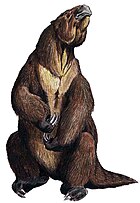Mylodontinae
| Mylodontinae Temporal range: Middle Miocene to Early Holocene (Hemphillian-Rancholabrean (NALMA) & Colloncuran-Lujanian (SALMA)
~ | |
|---|---|

| |
| Skeleton of Glossotherium robustum at the Natural History Museum, London | |
| Scientific classification | |
| Domain: | Eukaryota |
| Kingdom: | Animalia |
| Phylum: | Chordata |
| Class: | Mammalia |
| Order: | Pilosa |
| Family: | †Mylodontidae |
| Subfamily: | †Mylodontinae Gill, 1872 |
| Subgroups | |
| |
Mylodontinae is an extinct subfamily of ground sloths that lived from the Early Miocene to the Early Holocene epochs.[1]
Classification
[edit]The classification of the Mylodontidae is complex and often under discussion. The most widely accepted subfamilies are the Mylodontinae with Mylodon as the type genus and the Lestodontinae, whose type genus is Lestodon, which sometimes also includes Paramylodon and Glossotherium (sometimes also listed as belonging to the tribes Mylodontini and Lestodontini.[2] The subdivision of the terminal group of mylodonts into the Lestodontinae and Mylodontinae found confirmation in one of the most comprehensive studies of the phylogeny of sloths based on cranial features in 2004,[3] which subsequently found multiple support.[4][5] However, a later analysis from 2019 cast doubt on it again.[6] A higher-resolution phylogenetic study of the mylodonts published in the same year again supports the branching of terminal forms. According to this, the Mylodontinae and Lestodontinae can be distinguished on the basis of the canine anterior teeth. In the latter, these are large and separated from the posterior teeth by a long diastema; the former, on the other hand, have only small or partially reduced caniniform teeth, which are usually more closely apposed to the molar-like teeth.[1] Numerous other subfamilies have been established in the past, including, for example, the Nematheriinae for representatives from the Lower Miocene or the Octomylodontinae for all basal forms. Their recognition varies mostly depending on the author.[7] Another subfamily, the Urumacotheriinae, were established only in 2004. Their basal position consists of the late Miocene representatives of northern South America.[8] In principle, a revision for the entire family is urged, since many of the higher taxonomic units lack a formal diagnosis.[9]
Below is a phylogenetic tree of the Mylodontinae, based on the work of Boscaini and colleagues (2019).[1]
References
[edit]- ^ a b c Boscaini, Alberto; Pujos, François; Gaudin, Timothy J. (November 2019). "A reappraisal of the phylogeny of Mylodontidae (Mammalia, Xenarthra) and the divergence of mylodontine and lestodontine sloths". Zoologica Scripta. 48 (6): 691–710. doi:10.1111/zsc.12376. S2CID 201194980.
- ^ Theodor, Jessica M. (December 1998). "Classification of Mammals: Above the Species Level.Malcolm C. McKenna , Susan K. Bell". The Quarterly Review of Biology. 73 (4): 518–519. doi:10.1086/420478. ISSN 0033-5770.
- ^ Gaudin, Timothy J. (2004). "Phylogenetic relationships among sloths (Mammalia, Xenarthra, Tardigrada): the craniodental evidence". Zoological Journal of the Linnean Society. 140 (2): 255–305. doi:10.1111/j.1096-3642.2003.00100.x. ISSN 1096-3642. S2CID 38722942.
- ^ Rincón, Ascanio D.; Solórzano, Andrés; McDonald, H. Gregory; Flores, Mónica Núñez (2017-06-01). "Baraguatherium takumara, Gen. et Sp. Nov., the Earliest Mylodontoid Sloth (Early Miocene) from Northern South America". Journal of Mammalian Evolution. 24 (2): 179–191. doi:10.1007/s10914-016-9328-y. ISSN 1573-7055. S2CID 254703922.
- ^ Brambilla, Luciano; Ibarra, Damián Alberto (2018-11-02). "Archaeomylodon sampedrinensis, gen. et sp. nov., a new mylodontine from the middle Pleistocene of Pampean Region, Argentina". Journal of Vertebrate Paleontology. 38 (6): e1542308. Bibcode:2018JVPal..38E2308B. doi:10.1080/02724634.2018.1542308. ISSN 0272-4634. S2CID 91874640.
- ^ Varela, Luciano; Tambusso, P. Sebastián; McDonald, H. Gregory; Fariña, Richard A. (2018). "Phylogeny, Macroevolutionary Trends and Historical Biogeography of Sloths: Insights From a Bayesian Morphological Clock Analysis". Systematic Biology. 68 (2): 204–218. doi:10.1093/sysbio/syy058. ISSN 1063-5157. PMID 30239971.
- ^ Rinderknecht, Andrés; T., Enrique Bostelmann; Perea, Daniel; Lecuona, Gustavo (2010). "A new genus and species of Mylodontidae (Mammalia: Xenarthra) from the late Miocene of southern Uruguay, with comments on the systematics of the Mylodontinae". Journal of Vertebrate Paleontology. 30 (3): 899–910. Bibcode:2010JVPal..30..899R. doi:10.1080/02724631003757997. ISSN 0272-4634. S2CID 86604163.
- ^ Negri, Francisco (2004). "Urumacotheriinae, nova subfamília de Mylodontidae (Mammalia, Tardigrada) do Mioceno superior-Plioceno, América do Sul". Revista Brasileira de Paleontologia. 7 (2): 281–288. doi:10.4072/rbp.2004.2.23. ISSN 1519-7530.
- ^ Rincón, Ascanio D.; McDonald, H. Gregory; Solórzano, Andrés; Flores, Mónica Núñez; Ruiz-Ramoni, Damián (2015). "A new enigmatic Late Miocene mylodontoid sloth from northern South America". Royal Society Open Science. 2 (4): 150138. Bibcode:2015RSOS....250138R. doi:10.1098/rsos.150138. PMC 4448861. PMID 26065399.


